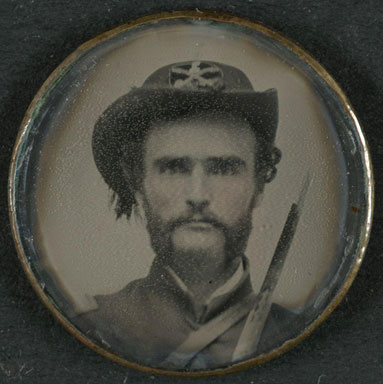Are you using a 150-year-old story format?
At about the time this Union soldier marched off to war, journalists invented the traditional news structure that you use every day.
Let’s pause and ponder that for a minute.

You know the inverted pyramid — that hierarchical blurtation of facts that starts with the most important element and moves to the least.
It’s often paired with the fact pack, where you stuff who, what, when, where, why and how into the first paragraph. (I always wondered, if you cover all the W’s in the lead, what’s left for the second paragraph?)
But where did this thing come from?
Have you seen the movie ‘Lincoln’?
The inverted pyramid was invented in the late 19th century, the product of a then-new communications technology, the telegraph, which was invented in 1854.
The telegraph meant that for the first time, reporters could get war stories home from battle without engaging a man on horseback to take the story back home.
That made the Civil War one of the golden ages of newspaper reporting. For the first time, readers could learn about battles in real time — or what passed for real time back in the day.
Before the telegraph, reporters told war stories chronologically: Two great armies meet on a hill. The first shot is fired; a man goes down on this side. Another shot is volleyed, and a soldier dies over here.
But what happens to a telegraph wire that runs along the ground during a ground war? Bullets hit it; corpses fall on it; cannon balls land on it, and the wire gets cut.
Send a chronological story over a telegraph wire, it could get interrupted at any point: Two great armies — rrrrip! — and the story is over.
Hierarchical replaces chronological order.
So reporters started telling stories in hierarchical order: The blue team won! “Oh, I have more time; what a luxury.” Twenty men died! “Even more time; isn’t that nice?” And on and on until the story got out or the wire got cut, whichever came first.
And thus began the hierarchical blurtation of facts that is the inverted pyramid.
The evolution of linotype reinforced the pyramid. Editors dealing with columns of lead found it easier to cut stories from the bottom rather than tweaking them from the middle.
These days, 25 years of research tells us that while the inverted pyramid worked beautifully for distributing information over a telegraph wire, it does not work so well with readers.
When to use the inverted pyramid
That doesn’t mean there’s never a time to use the inverted pyramid. Use the traditional news format whenever you need to:
- Communicate urgent information. If the building were on fire, for instance, you wouldn’t want a feature lead. As the flames licked the secretary’s desk on the first floor … No, you’d want me to say, “The building’s on fire! Get out of the building now!”
- Share bad news. Communicating about layoffs? Let’s skip the feature lead where we paint a picture of the glorious new life readers will lead as they get to pursue a brand-new career. Instead write as clearly and cleanly as you can. Avoid obfuscation.
- Distribute your story via telegraph wire. Enough said.
For the rest of the time, writers must master an approach that works when the inverted pyramid doesn’t. And that approach is the feature-style story structure.
___
Source: Chip Scanlan, “Birth of the Inverted Pyramid: A Child of Technology, Commerce and History,” PoynterOnline, Dec. 17, 2003

Seriously Ann, do you preach this because it’s solid journalism or it appeals to young people who question anything 150 years old — and puts butts in your seminar seats?
I’ve done a Google search, asked a writer at a sizeable newspaper, and asked a J school freshmen: Everyone says the IP is still in news writing Gospel and with just cause.
News writers still have word counts, column inches, and space requirements. AND, especially in Internet writing, where space is even more precious, you gotta sell a reader within a few seconds. They won’t dig through a disorganized article to find key facts … they’ll just click on the next link for something coherently written.
You may think this is catchy to sell your program, but it is a disservice to young writers.
Hi JC,
Which of these stories would you rather read? https://www.wyliecomm.com/2018/07/feature-style-story-form-easy-as-1-2-3/
1) I agree. The inverted pyramid remains Gospel, despite the fact that it’s been proven not to work well with humans. That doesn’t mean it makes sense to continue to use it.
2) We find that word counts usually go down when we transform inverted pyramids into feature-style stories, mostly because writers can better figure out what to include.
3) Disorganization and feature-style story structure don’t go hand-in-hand, because features actually give you a place for everything. In my experience, disorganization tends to travel more with inverted pyramid, which directs us only to organize from most to least important.
4) The best writers lift ideas off the page with display copy, as well as pointedly in the copy. Better to sell readers (and tell them) before the story even gets started, as well as several places within the story.
I believe the disservice is to continue to rely on the way we’ve always done it just because we’ve always done it that way — and because your friend and a J-school freshman said so.
It is a disservice to young writers to continue to champion a form long past its expiration date. Even the AP has largely abandoned the pyramid. http://niemanreports.org/articles/no-time-left-for-reluctant-transformers/
We know from research hot to attract and keep readers. It is with storytelling. We also know from research and from Google which stories are shared the most (Facebook is really a media company) and which stories end up on the first page of search. It is feature stories, generally about 2,000 words long. Google rewards depth. Online readers — the kind you want — demand depth.
Nearly everything you’ve said is contradicted by available research.